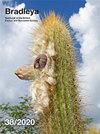A new species of Cumulopuntia (Cactaceae) from Peru
IF 1.2
4区 生物学
Q3 PLANT SCIENCES
引用次数: 0
Abstract
Summary: A new species of Cumulopuntia (C. mollispina) is described and illustrated. The species is a narrow endemic from the Valley of the Rio Yauca, in the Department of Ayacucho near the frontier with the Department of Arequipa. It is known only from a small geographical area with a narrow elevation range of 1,700–1,800m. It is a member of the informal ‘Cumulopuntia sphaerica’ clade (=Sphaeropuntia Guiggi) but differs from all other members by growing as a hemispherical or slightly flattened cushion of tightly packed segments with soft flexible spination. We compare the new taxon with three other Cumulopuntia species: C. leucophaea, C. multiareolata and C. zehnderi, which all grow within 60km of C. mollispina. Zusammenfassung: Eine neue Cumulopuntia-Art, C. mollispina, wird beschrieben und abgebildet. Die Art ist ein enger Endemit aus dem Tal des Rio Yauca im Departamento Ayacucho nahe der Grenze zum Departamento Arequipa. Sie ist nur aus einem kleinen geografischen Gebiet mit einem schmalen Höhenbereich von 1700 bis 1800m bekannt. Sie gehört zur informellen Cumulopuntia sphaericaKlade (=Sphaeropuntia Guiggi), unterscheidet sich aber von allen anderen Vertretern durch ihren halbkugelförmigen oder leicht abgeflachten Polsterwuchs aus dicht gepackten Segmenten mit weicher, flexibler Bedornung. Wir vergleichen das neue Taxon mit drei anderen Cumulopuntia-Arten, C. leucophaea, C. multiareolata und C. zehnderi, die alle im Umkreis von 60km von C. mollispina wachsen.标题秘鲁仙人掌属一新种
提示:英国伦敦这种物种从里奥卡谷发迹,原属亚非克省前沿地带。它只是从一个很小的地理地区位于一个干涸的斜坡他是中情局中的一位成员我们对新的冠上和其他三人在一起,c。总结:一种新的毛囊病类型c。该种鸟类来自Rio Yauca谷地靠近靠近Departamento arampa的边界。它只出生在一小片地理范围内,海拔范围由1700至1800米不等。它属于非正式的姓名(称为斯帕弗罗廷灰圆柱),但它与其他许多人的区别在于,它采用半球形的、易盖的、灵活的涂鸦装饰。我们将新的Taxon跟另外三种卡蓬,c。
本文章由计算机程序翻译,如有差异,请以英文原文为准。
求助全文
约1分钟内获得全文
求助全文
来源期刊

Bradleya
PLANT SCIENCES-
CiteScore
2.80
自引率
25.00%
发文量
43
审稿时长
>12 weeks
期刊介绍:
Bradleya is the BCSS contribution to the scientific world and is accepted as such because of its academic standards. It can only flourish with the support of BCSS members, many of whom subscribe to it each year. The aim is to include articles which our members will find interesting and educational, whilst retaining rigorous standards of publication. Scientifically important articles don''t have to be dull to read. So, because Bradleya depends the subscriber, the editor endeavours to make its contents accessible, easily understood and enjoyable for all.
 求助内容:
求助内容: 应助结果提醒方式:
应助结果提醒方式:


